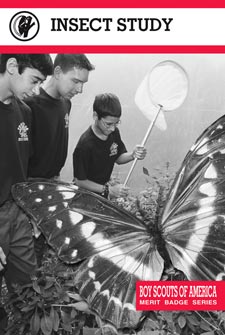The booklet shown above is the OLD booklet, and has been superceded.
- Tell how insects are different from all other animals. Show how insects are different from centipedes and spiders.
- Point out and name the main parts of an insect.
- Collect and mount 50 different species.* Include
six orders and 18 families of insects. Label each with common and scientific
names, where possible.
4. Describe the characteristics that distinguish the principal families and orders of insects. - Do the following:
- Observe 20 different live species of insects in their habitat. In your observations, include at least four orders of insects.
- Make a scrapbook of the 20 insects you observe in 4a. Include photographs, sketches, illustrations, and articles. Label each insect with its common and scientific names, where possible. Share your scrapbook with your merit badge counselor.
- Do the following:
- From your scrapbook collection, identify three species of insects helpful to humans and five species of insects harmful to humans.
- Describe some general methods of insect control.
- Compare the life histories of a butterfly and a grasshopper. Tell how they are different.
- Raise an insect through the complete metamorphosis from its larval stage to its adult stage (e.g. raise a butterfly or moth from a caterpillar.*
- Tell the things that make social insects different
from solitary insects.
Observe an ant colony or a beehive. Tell that you saw. - Observe an ant colony or a beehive. Tell that
you saw.
Tell the things that make social insects different from solitary insects. - From your collection, identify:
- Four species of insects helpful to humans.
- Six species of insects harmful to humans.
Describe some general methods of insect control.
- Find out about three career opportunities in insect study. Pick one and find out about the education, training, and experience required for this profession. Discuss this with your counselor, and explain why this profession might interest you.
*Some insects are endangered species and are protected by federal or state law. Every species is found only in its own special type of habitat. Be sure to check natural resources authorities in advance to be sure that you will not be collecting any species that is known to be protected or endangered, or in any habitat where collecting is prohibited. In most cases, all specimens should be returned at the location of capture after the requirement is met. Check with your merit badge counselor for those instances where the return of these specimens would not be appropriate.
BSA Advancement ID#:
65
Requirements last updated in:
2008
Pamphlet Publication Number:
35911
Pamphlet Stock (SKU) Number:
35911
Pamphlet Revision Date:
2008
| Worksheets for use in working on these requirements: | Format | |
|---|---|---|
| Word Format | PDF Format | |
Page updated on: November 18, 2021









